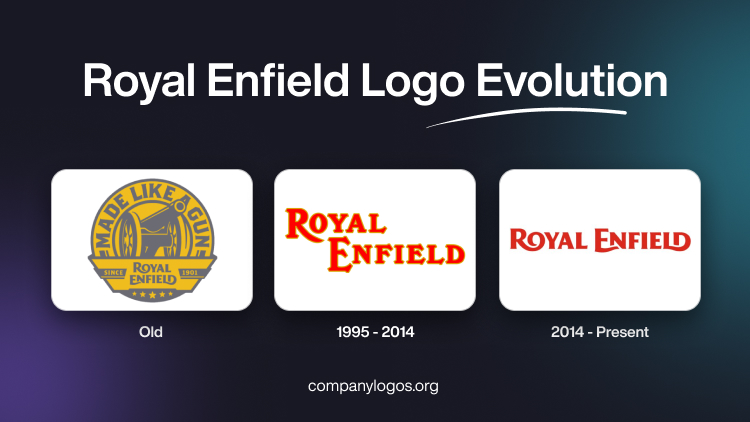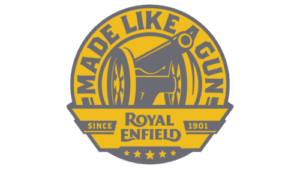
Royal Enfield is one of the premier marquee motorcycle brands in the world with a rich history that dates back to 1901. Founded by entrepreneurs Bob Walker Smith and Albert Eadie in Redditch, England, the company went on to become known for durability, endurance, and precision. So, be it the rugged terrain of the Himalayas or the vast expanse of the highways in the hinterland, Royal Enfield has remained a faithful and dependable companion of countless drivers.
The Royal Enfield logo is a visual chronicle of one of the world’s oldest motorcycle brands. It reflects a journey from British industrial roots to Indian cultural icon. Its evolution shows the transformation, technological advancements, and enduring legacy of the brand. The article delves into the evolution of the Royal Enfield logo, among other details of the company.
The Genesis of the Royal Enfield Logo (Old)
The original logo of Royal Enfield featured a roundel in mustard yellow with grey outlines and a wide ribbon at the bottom. At the centre of the roundel was placed a cannon in black with yellow contours to reflect the armament connection of the brand. Along the circumference of the roundel was mentioned the iconic slogan “MADE LIKE A GUN” in greyish colour in uppercase with sharp serifs and diagonal cuts. The wide ribbon at the bottom displayed the brand name in two levels and the date of establishment (1901). The bottom of the emblem had five stars of varying sizes to symbolise the premium quality of the motorcycles.

(1995 – 2014)
The 1995 logo came about with the taking over of Royal Enfield by Enfield India. As a result, the cannon motif and the multi-element emblem were removed. In its place appeared a simple wordmark depicting the brand name using decorative serifs. The serifs on the letters “A” and “Y” were horizontal, while they were pointed downwards in “F” and “E.” Further, the leg of “R” was extended to make it appear like a sharp blade-like shape. The thin golden outlines on a predominantly red-coloured wordmark created a sense of luxury and sophistication.

(2014 – Present)
The current logo in dark red was designed in 2014, and it retains a few features of its previous iteration. The brand name is rendered in a customised typeface with sharp and short serifs. Besides, the extended legs of “R,” “E,” and “D” with smooth curves that overlap with neighbouring glyphs add uniqueness to the logo.

The Elements of the Royal Enfield Logo
Font
The Royal Enfield logo employs a custom typeface with sharp and short serifs. The thickened letters of the wordmark offer the logo a visually embossed look. Further, the “R,” “E,” and “D” feature extended lines that overlap with neighbouring glyphs. The font used to write the wordmark is similar to Clear Gothic Pro Xbold by SoftMaker and Brothers Bold by Emigre.
Colour
The Royal Enfield logo has a colour palette comprising greyish shades of yellow, grey, and red. The colours evoke a sense of restrained love for motorcycles. Besides, the overall red colour of the logo represents the colour of adrenaline, energy, vitality, and movement.
The History of Royal Enfield
Royal Enfield is one of the world’s oldest motorcycle brands in continuous production. It boasts of a rich history that dates back to the late 19th century. The company was founded in 1891, when the founders Bob Walker Smith and Albert Eadie acquired George Townsend & Co., a needle manufacturer in Redditch, England, which had recently diversified into bicycles. In 1892, after securing a contract to supply precision parts to the Royal Small Arms Factory in Enfield, Middlesex, the company was renamed Enfield Manufacturing Company Ltd.
Their first bicycles were branded “Enfield,” and soon after, the company adopted the name Royal Enfield. It introduced the iconic slogan “Made Like a Gun,” which referred to both their armaments connection and the brand’s reputation for durability. By 1898, Royal Enfield had produced its first motorised vehicle, which was a 1.5 HP quadricycle, and in 1901, the company launched its first motorcycle, the “Motor Bicycle.” It featured a 1.5 HP Minerva engine.
Over the early 20th century, Royal Enfield expanded its product range. It started manufacturing motorcycles, bicycles, lawnmowers, and stationary engines. The company became renowned for robust engineering and innovation and supplied motorcycles for both World Wars. In 1932, Royal Enfield introduced the Bullet, a model that would go on to become the world’s longest-running motorcycle in continuous production.
The Indian chapter of Royal Enfield began in 1949, when its motorcycles were first sold in India. In 1955, the Indian government selected the Bullet 350 for military and police use due to its ruggedness. This led to a partnership with Madras Motors to form Enfield India in Chennai (then Madras). Initially, bikes were assembled from kits imported from the UK, but by 1962, all components were manufactured in India. This made the company a fully indigenous operation. While the Redditch factory in England closed in 1970, the production of motorcycles in India continued unabated.
A major turning point came in 1994, when Enfield India was acquired by Eicher Motors, an Indian automotive conglomerate. This ushered in a new era of investment and modernisation. Despite challenges in the 1990s, Royal Enfield experienced a remarkable revival in the 21st century. It opened new factories in Chennai to meet the growing demand and expanded its lineup to include popular models such as the Classic, Thunderbird, Himalayan, Interceptor 650, and Super Meteor 650.
Based in Chennai, Royal Enfield exports motorcycles worldwide and is celebrated for its blend of classic design and modern engineering. It maintains a strong cult following among bike enthusiasts. The company’s journey from a British bicycle and arms parts manufacturer to a global motorcycle icon is remarkable indeed. It is marked by resilience, adaptability, and a unique ability to blend tradition with innovation.
Interesting Facts About Royal Enfield
- The Royal Enfield Bullet holds the distinction of being the longest-running motorcycle model in continuous production in the world. It was first launched in 1932 and has been produced without interruption since then.
- The origins of Royal Enfield date back to 1901 when the first motorcycle was built by the Enfield Cycle Company in Redditch, England. The company originally manufactured precision parts for the Royal Small Arms Factory, which inspired the brand’s famous slogan “Made Like a Gun” and the use of a cannon in its logo.
- The Bullet became especially popular in India after 1955, when the Indian government chose it for its police and military forces. This led to the establishment of Enfield India in partnership with Madras Motors. This marked the beginning of Royal Enfield’s deep roots in India.
- Despite the closure of the original UK factory in 1970 due to competition from Japanese motorcycles, Royal Enfield thrived in India and eventually began exporting motorcycles back to the UK and Europe from 1977 onwards.
- During wartime, Royal Enfield motorcycles were fitted with sidecars mounted with machine guns. These were majorly used by Allied forces during the Second World War.
- The Bullet’s design has remained remarkably consistent over the decades. It has retained its classic handcrafted look while gradually incorporating modern technology. This included electric starters and disc brakes to balance heritage with contemporary performance.
- Royal Enfield has expanded its lineup beyond the Bullet to include models like the Classic 350, Thunderbird, Himalayan (an adventure touring bike), and twin-cylinder motorcycles such as the Interceptor 650 and Continental GT.
- The company’s headquarters and manufacturing units are now based in Chennai, India, where it continues to innovate while celebrating its rich history. This makes Royal Enfield a unique blend of British legacy and Indian motorcycle culture.
- The brand’s founder, Major Frank Walker Smith, famously predicted in 1933 that “Bullets will be flying peacefully about the countryside, from Calcutta to Bombay and from the Himalayas to Cape Comorin. This prophecy has been fulfilled, as Royal Enfield motorcycles remain ubiquitous across India.
Finally
The Royal Enfield logo is more than a trademark. It is a living symbol of heritage, craftsmanship, and resilience. From the cannon of its British arsenal days to the bold wordmark of today, each logo iteration honours the past and embraces the future. The logo is inarguably one of the most recognised and revered emblems in the motorcycle world.